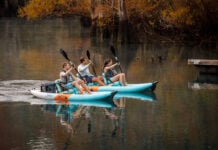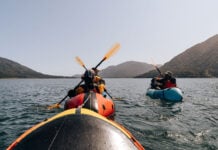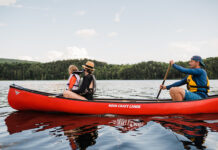The Official Scorecard
Comfort
No amount of money spent on barrel harnesses can overcome the physics that make a canoe pack more comfortable. Canoe packs are flatter, so the weight is closer to your back where it won’t swing around and send you off balance. True, you have to be sure not to pack your grill so it digs into your back, but that’s part of the fun.
WINNER: CANOE PACKSAnimals
Yes, barrels will keep your granola safe from rodents, and all but the most devious raccoons. No small victory there, but don’t be among those fooled into thinking they are impervious to bears. To a bear, a barrel is a blue taco shell.
WINNER: BLUE BARRELPrice
Prices are generally comparable. Understanding there is a huge range of canoe packs available, most fall in the same $150-$200 range you will pay for a 60-liter barrel and decent harness.
WINNER: TIEWeight
No contest here. Not only are canoe packs lighter, they also shrink in size as you eat your way through a trip.
WINNER: CANOE PACKSWaterproofness
The raison d’etre of barrels is their impermeability. Just be sure there is no debris in the gasket groove, and don’t store them with the lid securely on, lest the gasket get compressed.
WINNER: BLUE BARRELConvenience
Getting into a barrel is a two-step process, release the clasp and pop the lid. Canoe packs often have multiple buckles and folded flaps, and a myriad of stuff sacks within.
WINNER: BLUE BARRELPackability
A circle might be the perfect shape, but not when it comes to accepting cooksets, tents and tackle boxes. A properly packed canoe pack will have less wasted space than a rigid barrel. Soft items can be stuffed hard into barrels.
WINNER: TIESeating
For families accommodating paddling kids in the middle of a canoe, there is only one choice. Sitting on a soft, squared off canoe pack beats the bucking bronco that is a blue barrel every time.
WINNER: CANOE PACKS
A barrel’s ability to keep cargo safe and dry in whitewater has been evident since 1901, when Annie Taylor stuffed her ruffled dress into a wooden barrel and floated over the lip of Niagara Falls.
For the last 30 years, serious whitewater trippers have been using the seemingly bombproof blue barrel to keep their down sleeping bags and toilet paper dry as they crash down rivers in semi-swamped canoes. But what about flatwater trips? Do barrels’ attributes of security and convenience outweigh their uncomfortable, cumbersome and, some would say, ugly nature? Consider the ups and downs when deciding if you should roll out the barrel.
Blue barrels
Though exotic varieties exist, barrels commonly come in 30- and 60-liter sizes. Inside a groove on the black lid is a soft gasket, which is compressed to create a seal when the metal ring clasp is fitted and snapped closed.
Barrels are often given pantry duty, carrying food you don’t want to be crushed. The combined weight of 60 liters of food often crushes food from within, so packing food properly requires some care. Consider compartmentalizing the contents with supported internal tiers or dividers if you want to get fancy—and we know some of you “systems” types do. And definitely bag complete meals together for ease of retrieval.
Often overlooked is the barrel’s convenience around a campsite. If you use it for general camp gear like clothes, it can act like a Rubbermaid bin. Stand it upright in the campsite, and it will hold lots of stuff you need on an off-and-on basis, and it has a lid to rest on top keeping it all dry. Better than the half-dozen crammed stuff sacks living in your canoe pack.
The most important part is the gasket. If yours degrades it will let in water. You can order replacement lids online. The second-most important part of a barrel is a harness. Some are engineering marvels. Buy the right one, such as the Quick Haul Harness from North Water, and you might not hate carrying this chubby beast.
Canoe packs
On the other hand, no one ever smelled their canoe barrel when packing for a trip and got excited in a way that’s encouraged by the evocative aroma of a seasoned canvas and leather canoe pack. Supple packs don’t just look more at home in a canoe, they have undeniable advantages over barrels when it comes to their lighter weight, versatility, flexibility and packability. Despite not being aromatic like the traditional type, modern nylon packs don’t absorb water, and they have comfortable harness systems and plenty of compression straps for securing a load.
If you want to keep your gear totally waterproof from rain or floats down rapids, you’ll need to invest in a set of smaller, high-quality drybags or a liner, and do a little hoping for the best.
Making your choice: Canoe pack or blue barrel?
Rubberized canoe packs might seem like an appealing hybrid option between the two, but they suffer on scores of durability and waterproofness, and trying to pack items in nylon stuff sacks into that grabby rubber interior can be frustrating. Advice? Make room in your canoe for a barrel, even if just a 30-liter for select food items, and make it complement your other pack choices.
This article was first published in Issue 58 of Paddling Magazine. Subscribe to Paddling Magazine’s print and digital editions, or browse the archives.
It’s heavy either way. | Feature Photo: Robert Faubert









What about wanigans!?